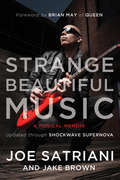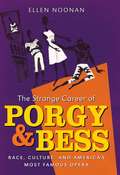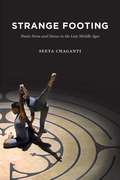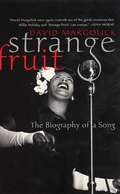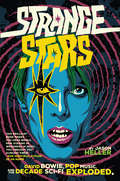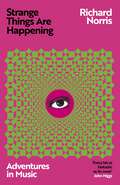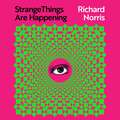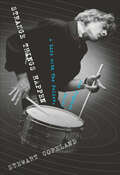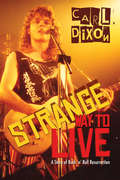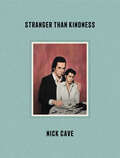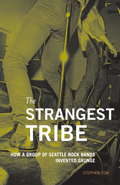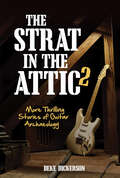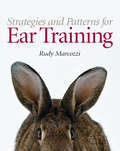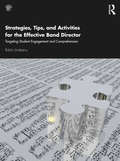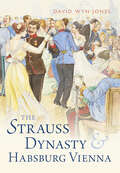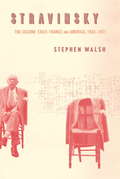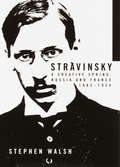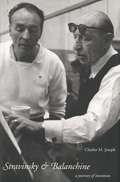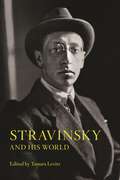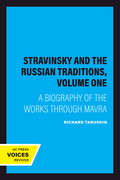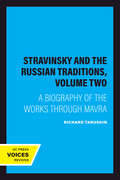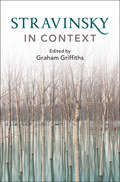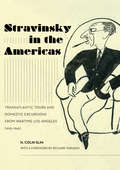- Table View
- List View
Strange Beautiful Music: A Musical Memoir
by Jake Brown Joe SatrianiGo behind the scenes with the musician The New York Times called "a guitar God!" Oft-hailed as the Jimi Hendrix of his generation, living guitar legend Joe Satriani has long transcended stylistic boundaries with a sound that raises the bar like a new horizon for the broader genre of instrumental guitar rock. Joe's 6-string secrets have astounded listeners around the world for nearly 30 years.In Strange Beautiful Music: A Musical Memoir, Satriani and coauthor, music biographer Jake Brown, take fans on their first authorized tour of the story behind his climb to stardom and the creative odyssey involved in writing and recording a storied catalog of classics including "Surfing with the Alien," "Summer Song," "Satch Boogie," "Always With Me, Always With You," "The Extremist," "Flying in a Blue Dream," "Crowd Chant," and more.Featuring previously unpublished photos and hours of exclusive, firsthand interviews with Satriani, Strange Beautiful Music offers a unique look inside the studio with Joe, giving fans a chance to get up close and personal like never before. With insider details about his collaboration with multi-platinum supergroup Chickenfoot, exclusive interviews with Sammy Hagar and Michael Anthony of Van Halen and Chad Smith of the Red Hot Chili Peppers, commentary from fellow guitar legends such as Steve Vai, Metallica's Kirk Hammett, Primus's Larry LaLonde, and legendary music producers including Glynn Johns and the late Andy Johns, this memoir offers a rare inside look for die-hard Satriani fans, guitar enthusiasts, and anyone who loves to rock.
The Strange Career of Porgy and Bess
by Ellen NoonanCreated by George Gershwin and DuBose Heyward and sung by generations of black performers, Porgy and Bess has been both embraced and reviled since its debut in 1935. In this comprehensive account, Ellen Noonan examines the opera's long history of invention and reinvention as a barometer of twentieth-century American expectations about race, culture, and the struggle for equality. In its surprising endurance lies a myriad of local, national, and international stories.For black performers and commentators, Porgy and Bess was a nexus for debates about cultural representation and racial uplift. White producers, critics, and even audiences spun revealing racial narratives around the show, initially in an attempt to demonstrate its authenticity and later to keep it from becoming discredited or irrelevant. Expertly weaving together the wide-ranging debates over the original novel, Porgy, and its adaptations on stage and film with a history of its intimate ties to Charleston, The Strange Career of "Porgy and Bess" uncovers the complexities behind one of our nation's most long-lived cultural touchstones.
Strange Footing: Poetic Form and Dance in the Late Middle Ages
by Seeta ChagantiFor premodern audiences, poetic form did not exist solely as meter, stanzas, or rhyme scheme. Rather, the form of a poem emerged as an experience, one generated when an audience immersed in a culture of dance encountered a poetic text. Exploring the complex relationship between medieval dance and medieval poetry, Strange Footing argues that the intersection of texts and dance produced an experience of poetic form based in disorientation, asymmetry, and even misstep. Medieval dance guided audiences to approach poetry not in terms of the body’s regular marking of time and space, but rather in the irregular and surprising forces of virtual motion around, ahead of, and behind the dancing body. Reading medieval poems through artworks, paintings, and sculptures depicting dance, Seeta Chaganti illuminates texts that have long eluded our full understanding, inviting us to inhabit their strange footings askew of conventional space and time. Strange Footing deploys the motion of dance to change how we read medieval poetry, generating a new theory of poetic form for medieval studies and beyond.
Strange Fruit: The Biography Of A Song
by David MargolickRecorded by jazz legend Billie Holiday in 1939, "Strange Fruit" is considered to be the first significant song of the civil rights movement and the first direct musical assault upon racial lynchings in the South. Originally sung in New York's Cafe Society, these revolutionary lyrics take on a life of their own in this revealing account of the song and the struggle it personified. Strange Fruit not only chronicles the civil rights movement from the '30s on, it examines the lives of the beleaguered Billie Holiday and Abel Meeropol, the white Jewish schoolteacher and communist sympathizer who wrote the song that would have an impact on generations of fans, black and white, unknown and famous, including performers Lena Horne, Eartha Kitt, and Sting.
Strange Stars: How Science Fiction and Fantasy Transformed Popular Music
by Jason HellerA Hugo Award-winning author and music journalist explores the weird and wild story of when rock ’n’ roll met the sci-fi world of the 1970sAs the 1960s drew to a close, and mankind trained its telescopes on other worlds, old conventions gave way to a new kind of hedonistic freedom that celebrated sex, drugs, and rock ’n’ roll. Derided as nerdy or dismissed as fluff, science fiction rarely gets credit for its catalyzing effect on this revolution.In Strange Stars, Jason Heller recasts sci-fi and pop music as parallel cultural forces that depended on one another to expand the horizons of books, music, and out-of-this-world imagery.In doing so, he presents a whole generation of revered musicians as the sci-fi-obsessed conjurers they really were: from Sun Ra lecturing on the black man in the cosmos, to Pink Floyd jamming live over the broadcast of the Apollo 11 moon landing; from a wave of Star Wars disco chart toppers and synthesiser-wielding post-punks, to Jimi Hendrix distilling the “purplish haze” he discovered in a pulp novel into psychedelic song. Of course, the whole scene was led by David Bowie, who hid in the balcony of a movie theater to watch 2001: A Space Odyssey, and came out a changed man…If today’s culture of Comic Con fanatics, superhero blockbusters, and classic sci-fi reboots has us thinking that the nerds have won at last, Strange Stars brings to life an era of unparalleled and unearthly creativity—in magazines, novels, films, records, and concerts—to point out that the nerds have been winning all along.
Strange Things Are Happening
by Richard Norris'The rainbow reaches right across the sky, for miles and miles, and has landed right in the middle of our field. My mother, Alison, is standing at the beginning. I'm sure it's a beginning, rather than the end, as there's no pot of gold in sight. The point where everything forms or, perhaps, is not quite formed as yet. That's my favourite place. A place alive with possibility.'Strange Things Are Happening begins with the wonder of that rainbow, and continues with many escapades down the rabbit hole. From punk and the beginnings of the DIY scene, through Acid House, psychedelia, the rise of electronic dance music and much more, Richard Norris has been involved in countless countercultural revolutions. From misadventures in Amsterdam with Timothy Leary, with Sun Ra at customs, and Shaun Ryder in Joe Strummer's beaten up Cadillac in Tijuana, to his extraordinarily influential output in The Grid and Beyond The Wizards Sleeve, Richard Norris' story is one of collaboration and community, fuelled by relentless psychedelic curiosity.Strange Things Are Happening is a record of a life lived in the moment, forever in thrall to discovery, exploration and innovation - the search for what lies at the other end of that rainbow.
Strange Things Are Happening
by Richard Norris'The rainbow reaches right across the sky, for miles and miles, and has landed right in the middle of our field. My mother, Alison, is standing at the beginning. I'm sure it's a beginning, rather than the end, as there's no pot of gold in sight. The point where everything forms or, perhaps, is not quite formed as yet. That's my favourite place. A place alive with possibility.'Strange Things Are Happening begins with the wonder of that rainbow, and continues with many escapades down the rabbit hole. From punk and the beginnings of the DIY scene, through Acid House, psychedelia, the rise of electronic dance music and much more, Richard Norris has been involved in countless countercultural revolutions. From misadventures in Amsterdam with Timothy Leary, with Sun Ra at customs, and Shaun Ryder in Joe Strummer's beaten up Cadillac in Tijuana, to his extraordinarily influential output in The Grid and Beyond The Wizards Sleeve, Richard Norris' story is one of collaboration and community, fuelled by relentless psychedelic curiosity.Strange Things Are Happening is a record of a life lived in the moment, forever in thrall to discovery, exploration and innovation - the search for what lies at the other end of that rainbow.
Strange Things Are Happening: Adventures in Music
by Richard Norris'The rainbow reaches right across the sky, for miles and miles, and has landed right in the middle of our field. My mother, Alison, is standing at the beginning. I'm sure it's a beginning, rather than the end, as there's no pot of gold in sight. The point where everything forms or, perhaps, is not quite formed as yet. That's my favourite place. A place alive with possibility.'Strange Things Are Happening begins with the wonder of that rainbow, and continues with many escapades down the rabbit hole. From punk and the beginnings of the DIY scene, through Acid House, psychedelia, the rise of electronic dance music and much more, Richard Norris has been involved in countless countercultural revolutions. From misadventures in Amsterdam with Timothy Leary, with Sun Ra at customs, and Shaun Ryder in Joe Strummer's beaten up Cadillac in Tijuana, to his extraordinarily influential output in The Grid and Beyond The Wizards Sleeve, Richard Norris' story is one of collaboration and community, fuelled by relentless psychedelic curiosity.Strange Things Are Happening is a record of a life lived in the moment, forever in thrall to discovery, exploration and innovation - the search for what lies at the other end of that rainbow.
Strange Things Happen: A Life with The Police, Polo, and Pygmies
by Stewart CopelandWhen Stewart Copeland gets dressed, he has an identity crisis. Should he put on "leather pants, hostile shirts, and pointy shoes"? Or wear something more appropriate to the "tax-paying, property-owning, investment-holding lotus eater" his success has allowed him to become? This dilemma is at the heart of Copeland's vastly entertaining memoir-in-stories, Strange Things Happen. The world knows Copeland as the drummer for The Police, one of the most successful bands in rock history. But they may not know as much about his childhood in the Middle East as the son of a CIA agent. Or be aware of his film-making adventures with the Pygmies in the deepest reaches of the Congo, and his passion for polo (Brideshead Revisited on horses). In Strange Things Happen we move from Copeland's remarkable childhood to the formation of The Police, their rise to stardom, and the settled-down life that followed. It ends with a behind-the-scenes view of The Police's extraordinarily successful reunion tour. It's a book of amazing anecdotes, all completely true, which take us backstage in a life that is fully lived.
Strange Way to Live: A Story of Rock 'n' Roll Resurrection
by Carl DixonCarl Dixon’s journey through the twists and turns of a music performer’s life began in Northern Ontario, where his boyhood dreams, shaped by the 1960s, collided with a new musical culture. Though Carl’s road was rocky, it was still paved with gold. It has led from his early days with hard rockers Coney Hatch to tours and lasting friendships with huge acts like Iron Maiden. The ups and downs were meteoric. Carl became a member of the legendary bands The Guess Who and April Wine and then faced the hardest test of all: a horrific auto collision in Australia that left him in a coma, barely clinging to life. Strange Way to Live follows Carl’s progress, never faltering and sometimes comical, toward musical glory. Blind determination can lead one to some strange places. Carl’s took him through some of the biggest, smallest, and weirdest scenes in this vast country, and from the glory days of Canadian rock to the present day.
Stranger Than Kindness
by Nick CaveA journey in images and words into the creative world of musician, storyteller, and cultural icon Nick Cave.One of the world’s most celebrated artists, Nick Cave has enthralled and intrigued fans for more than four decades. With Stranger Than Kindness he reveals his innermost creative process as never before. Vibrant, evocative, and startlingly intimate, this remarkable volume peels back the layers of a unique artist, illuminating the inspiration that drives his work and exploring his many universes, both real and imagined.Featuring full color reproductions of original artwork, handwritten lyrics, photographs, and collected personal artifacts, Stranger Than Kindness ponders the origins of our deepest influences—what shapes our lives and makes us who we are—and celebrates the curiosity and power of the creative spirit.
The Strangest Tribe: How a Group of Seattle Rock Bands Invented Grunge
by Stephen TowGrunge isn't dead - but was it every truly alive? Twenty years after the height of the movement, The Strangest Tribe redefines grunge as we know it. Stephen Tow takes a second look at the music and community that vaulted the likes of Nirvana, Pearl Jam, Mudhoney, and Soundgarden to international fame. Chock-full of interviews with the starring characters, Tow extensively chronicles the rise of rock 'n' roll's last great statement and contextualizes what the music really meant to the key players. Delving deep into the archives, Tow paints a vivid picture of the underground rock circuit of tattered warehouses and community centers. Seattle's heady punk scene of the late '80s gave birth to a rowdy and raucous movement, influenced by metal, but wholly its own. Seattle made its own sound, a sound that came to be known internationally as grunge. Tow walks the reader through this sonic evolution, interviewing members of every band along the way. In 1991, Seattle's sound took the world by storm--but this same storm had been brewing in the Pacific Northwest for a decade before it hit MTV. The Strangest Tribe is a reframing of this last transformative era in music. Not just plaid shirts, bleached hair, and angst, "grunge" is a word used to describe a rich community of artists and jokers.
The Strat in the Attic 2: More Thrilling Stories of Guitar Archaeology
by Deke DickersonDon’t fret! The music historian and guitar sleuth brings you more astounding stories of rare guitar finds and the legends who owned them.Do you dream of finding a 1954 Stratocaster or 1952 Gibson Les Paul online, at a garage sale, or in the local penny saver? How about virtually rubbing elbows with one of your favorite rock legends? Following up his first-of-its-kind The Strat in the Attic, musician, journalist, and “guitarchaeologist” Deke Dickerson shares the stories behind dozens of more astounding finds including:A rarer-than-hens-teeth 1966 Hallmark Swept-Wing that originally belonged to Robbie Krieger of the Doors, stashed away in an attic in Alaska for forty years!A crazy-valuable 1958 Gibson Flying V belonging to a Chicago bluesman—who, it turns out, also happens to have an equally rare 1958 Gibson Explorer!An out-of-the-blue, a “to whom it may concern” email leads the author to a trailer park in Salem, Oregon, where one of Bob Wills and the Texas Playboys’ original 1940s Epiphone Emperor archtops is waiting to be purchased for a song!Luthier R.C. Allen relates the tales of buying Nat “King” Cole Trio guitarist Oscar Moore’s Stromberg Master 400 archtop and of being gifted a 1953 Standel amp from Merle Travis!Buddy Merrill, the amazingly talented guitarist from the Lawrence Welk show, gives his 1970 Micro-Frets Huntington to the author, but only if he “promises to PRACTICE.”Photos of the guitars and other exciting memorabilia round out a package that no vintage-guitar aficionado will want to be without!“The man knows how to tell a great story.” —Jonathan Kellerman, #1 New York Times–bestselling author
Strategies and Patterns for Ear Training
by Rudy MarcozziA complete, progressive course that teaches musicians how to notate music from audio examples, held on downloadable resources. Basic melodic dictation is followed by progressively more complex scores, in classical, jazz, and popular styles. Designed for the two year undergraduate sequence, Strategies and Patterns for Ear Training offers valuable strategies to students and teachers alike.
Strategies, Tips, and Activities for the Effective Band Director: Targeting Student Engagement and Comprehension
by Robin LinaberryStrategies, Tips, and Activities for the Effective Band Director: Targeting Student Engagement and Comprehension is a resourceful collection of highly effective teaching strategies, solutions, and activities for band directors. Chapters are aligned to cover common topics, presenting several practical lesson ideas for each topic. In most cases, each pedagogical suggestion is supported by excerpts from standard concert band literature. Topics covered include: score study shortcuts; curriculum development; percussion section management; group and individual intonation; effective rehearsal strategies; and much more! This collection of specific concepts, ideas, and reproducible pedagogical methods—not unlike short lesson plans—can be used easily and immediately. Ideal for band directors of students at all levels, Strategies, Tips, and Activities for the Effective Band Director is the product of more than three decades of experience, presenting innovative approaches, as well as strategies that have been borrowed, revised, and adapted from scores of successful teachers and clinicians.
The Strauss Dynasty and Habsburg Vienna
by David Wyn JonesThe music of the Strauss family – Johann and his three sons, Johann, Josef and Eduard – enjoys enormous popular appeal. Yet existing biographies have failed to do justice to the family's true significance in nineteenth and early twentieth-century musical history. David Wyn Jones addresses this deficiency, engagingly showing that – from Johann's first engagements in the mid-1820s to the death of Eduard in 1916 – the music making of the family was at the centre of Habsburg Viennese society as it moved between dance hall, concert hall and theatre. The Strauss industry at its height was, he demonstrates, greater than any one of the individuals, with serious personal and domestic consequences including affairs, illness, rivalry and fraud. This zesty biography, spanning over a hundred years of history, brings the dynasty brilliantly to life across a large canvas as it offers fresh and revealing insights into the cultural life of Vienna as a whole.
Stravinsky: France and America, 1934-1971
by Stephen WalshPicking up where the first volume left off, Walsh, a critic and musicologist at Cardiff U. , continues his biography of Russian composer Igor Stravinsky (1882-1971) from 1934 in France to his death in 1971. The biography follows his life and career from Paris to America, during a time when his wife died, he remarried, composed neoclassical works such as The Rake's Progress and Symphony in C, and dabbled in serialism. The first volume of the biography is Stravinsky: A Creative Spring: Russia and France, 1882-1934, which was published in 1999. Annotation ©2006 Book News, Inc. , Portland, OR (booknews. com)
Stravinsky: A Creative Spring: Russia and France, 1882-1934 (New Grove Composer Biographies Ser.)
by Stephen WalshWidely regarded the greatest composer of the twentieth century, Igor Stravinsky was central to the development of modernism in art. Deeply influential and wonderfully productive, he is remembered for dozens of masterworks, from The Firebird and The Rite of Spring to The Rake's Progress, but no dependable biography of him exists. Previous studies have relied too heavily on his own unreliable memoirs and conversations, and until now no biographer has possessed both the musical knowledge to evaluate his art and the linguistic proficiency needed to explore the documentary background of his life--a life whose span extended from tsarist Russia to Switzerland, France, and ultimately the United States.In this revealing volume, the first of two, Stephen Walsh follows Stravinsky from his birth in 1882 to 1934. He traces the composer's early Russian years in new and fascinating detail, laying bare the complicated relationships within his family and showing how he first displayed his extraordinary talents within the provincial musical circle around his teacher, Nikolay Rimsky-Korsakov. Stravinsky's brilliantly creative involvement with the Ballets Russes is illuminated by a sharp sense of the internal artistic politics that animated the group. Portraying Stravinsky's circumstances as an émigré in France trying to make his living as a conductor and pianist as well as a composer while beset by emotional and financial demands, Walsh reveals the true roots of his notorious obsession with money during the 1920s and describes with sympathy the nature of his long affair with Vera Sudeykina.While always respecting Stravinsky's own insistence that life and art be kept distinct, Stravinsky makes clear precisely how the development of his music was connected to his life and to the intellectual environment in which he found himself. But at the same time it demonstrates the composer's remarkably pragmatic psychology, which led him to consider the welfare of his art to be of paramount importance, before which everything else had to give way. Hence, for example, his questionable attitude toward Hitler and Mussolini, and his reputation as a touchy, unpredictable man as famous for his enmities as for his friendships.Stephen Walsh, long established as an expert on Stravinsky's music, has drawn upon a vast array of material, much of it unpublished or unavailable in English, to bring the man himself, in all his color and genius, to glowing life. Written with elegance and energy, comprehensive, balanced, and original, Stravinsky is essential reading for anyone interested in the adventure of art in our time.Praise from the British press for Stephen Walsh's The Music of Stravinsky "One of the finest general studies of the composer."--Wilfrid Mellers, composer, Times Literary Supplement"The beautiful prose of The Music of Stravinsky is itself a fund of arresting images. For those who already love Stravinsky's music, Walsh's essays on each work will bring a smile of recognition and joy at new kernels of insight. For those unfamiliar with many of the works he discusses, Walsh's commentaries are likely to whet appetites for performances of the works."--John Shepherd, Notes"This book sent me scurrying back to the scores and made me want to recommend it to other people. Above all, it is a good read."--Anthony Pople, Music and Letters
Stravinsky and Balanchine: A Journey of Invention
by Charles M. JosephThis book is about the collaboration of some of the greatest artists in the twentieth century, Igor Stravinsky and George Balanchine.
Stravinsky and His World (The Bard Music Festival #33)
by Tamara LevitzA new look at one of the most important composers of the twentith centuryStravinsky and His World brings together an international roster of scholars to explore fresh perspectives on the life and music of Igor Stravinsky. Situating Stravinsky in new intellectual and musical contexts, the essays in this volume shed valuable light on one of the most important composers of the twentieth century.Contributors examine Stravinsky's interaction with Spanish and Latin American modernism, rethink the stylistic label "neoclassicism" with a section on the ideological conflict over his lesser-known opera buffa Mavra, and reassess his connections to his homeland, paying special attention to Stravinsky's visit to the Soviet Union in 1962. The essays also explore Stravinsky's musical and religious differences with Arthur Lourié, delve into Stravinsky's collaboration with Pyotr Suvchinsky and Roland-Manuel in the genesis of his groundbreaking Poetics of Music, and look at how the movement within stasis evident in the scores of Stravinsky's Orpheus and Oedipus Rex reflected the composer's fierce belief in fate. Rare documents—including Spanish and Mexican interviews, Russian letters, articles by Arthur Lourié, and rarely seen French and Russian texts—supplement the volume, bringing to life Stravinsky's rich intellectual milieu and intense personal relationships.The contributors are Tatiana Baranova, Leon Botstein, Jonathan Cross, Valérie Dufour, Gretchen Horlacher, Tamara Levitz, Klára Móricz, Leonora Saavedra, and Svetlana Savenko.
Stravinsky and the Russian Period:
by Pieter C. van den Toorn John McginnessVan den Toorn and McGinness take a fresh look at the dynamics of Stravinsky's musical style from a variety of analytical, critical and aesthetic angles. Starting with processes of juxtaposition and stratification, the book offers an in-depth analysis of works such as The Rite of Spring, Les Noces and Renard. Characteristic features of style, melody and harmony are traced to rhythmic forces, including those of metrical displacement. Along with Stravinsky's formalist aesthetics, the strict performing style he favoured is also traced to rhythmic factors, thus reversing the direction of the traditional causal relationship. Here, aesthetic belief and performance practice are seen as flowing directly from the musical invention. The book provides a counter-argument to the criticism and aesthetics of T. W. Adorno and Richard Taruskin, and will appeal to composers, critics and performers as well as scholars of Stravinsky's music.
Stravinsky and the Russian Traditions, Volume One: A Biography of the Works through Mavra
by Richard TaruskinThis book undoes 50 years of mythmaking about Stravinsky's life in music. During his spectacular career, Igor Stravinsky underplayed his Russian past in favor of a European cosmopolitanism. Richard Taruskin has refused to take the composer at his word. In this long-awaited study, he defines Stravinsky's relationship to the musical and artistic traditions of his native land and gives us a dramatically new picture of one of the major figures in the history of music. Taruskin draws directly on newly accessible archives and on a wealth of Russian documents. In Volume One, he sets the historical scene: the St. Petersburg musical press, the arts journals, and the writings of anthropologists, folklorists, philosophers, and poets. Volume Two addresses the masterpieces of Stravinsky's early maturity—Petrushka, The Rite of Spring, and Les Noces. Taruskin investigates the composer's collaborations with Diaghilev to illuminate the relationship between folklore and modernity. He elucidates the Silver Age ideal of "neonationalism"—the professional appropriation of motifs and style characteristics from folk art—and how Stravinsky realized this ideal in his music. Taruskin demonstrates how Stravinsky achieved his modernist technique by combining what was most characteristically Russian in his musical training with stylistic elements abstracted from Russian folklore. The stylistic synthesis thus achieved formed Stravinsky as a composer for life, whatever the aesthetic allegiances he later professed. Written with Taruskin's characteristic mixture of in-depth research and stylistic verve, this book will be mandatory reading for all those seriously interested in the life and work of Stravinsky.
Stravinsky and the Russian Traditions, Volume Two: A Biography of the Works through Mavra
by Richard TaruskinThis book undoes 50 years of mythmaking about Stravinsky's life in music. During his spectacular career, Igor Stravinsky underplayed his Russian past in favor of a European cosmopolitanism. Richard Taruskin has refused to take the composer at his word. In this long-awaited study, he defines Stravinsky's relationship to the musical and artistic traditions of his native land and gives us a dramatically new picture of one of the major figures in the history of music. Taruskin draws directly on newly accessible archives and on a wealth of Russian documents. In Volume One, he sets the historical scene: the St. Petersburg musical press, the arts journals, and the writings of anthropologists, folklorists, philosophers, and poets. Volume Two addresses the masterpieces of Stravinsky's early maturity—Petrushka, The Rite of Spring, and Les Noces. Taruskin investigates the composer's collaborations with Diaghilev to illuminate the relationship between folklore and modernity. He elucidates the Silver Age ideal of "neonationalism"—the professional appropriation of motifs and style characteristics from folk art—and how Stravinsky realized this ideal in his music. Taruskin demonstrates how Stravinsky achieved his modernist technique by combining what was most characteristically Russian in his musical training with stylistic elements abstracted from Russian folklore. The stylistic synthesis thus achieved formed Stravinsky as a composer for life, whatever the aesthetic allegiances he later professed. Written with Taruskin's characteristic mixture of in-depth research and stylistic verve, this book will be mandatory reading for all those seriously interested in the life and work of Stravinsky.
Stravinsky in Context (Composers in Context)
by Graham GriffithsStravinsky in Context offers an alternative to chronological biography. Thirty-five short, specially commissioned essays explore the eventful life-tapestry from which Stravinsky's compositions emerged. The opening chapters draw on new research into the composer's childhood in St. Petersburg. Stravinsky's early, often traumatic upbringing is examined in depth, particularly in the context of his brother Roman's death, and religious sensibilities within the family. Further essays consider Stravinsky's years in exile at the centre of dynamic and ever-evolving cultural environments, the composer constantly refining his idiom and re-defining his aesthetics against a backdrop of world events and personal tragedy. The closing chapters review new material regarding Stravinsky's complicated relationship with the Soviet Union, whilst also anticipating his legacy from the varied perspectives of publishing, research and even - in the iconic example of The Rite of Spring - space exploration. The book includes previously unpublished images of the composer and his family.
Stravinsky in the Americas: Transatlantic Tours and Domestic Excursions from Wartime Los Angeles (1925-1945) (California Studies in 20th-Century Music #23)
by H. Colin SlimStravinsky in the Americas explores the “pre-Craft” period of Igor Stravinsky’s life, from when he first landed on American shores in 1925 to the end of World War II in 1945. Through a rich archival trove of ephemera, correspondence, photographs, and other documents, eminent musicologist H. Colin Slim examines the twenty-year period that began with Stravinsky as a radical European art-music composer and ended with him as a popular figure in American culture. This collection traces Stravinsky’s rise to fame—catapulted in large part by his collaborations with Hollywood and Disney and marked by his extra-marital affairs, his grappling with feelings of anti-Semitism, and his encounters with contemporary musicians as the music industry was emerging and taking shape in midcentury America. Slim’s lively narrative records the composer’s larger-than-life persona through a close look at his transatlantic tours and domestic excursions, where Stravinsky’s personal and professional life collided in often-dramatic ways.
